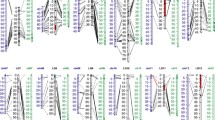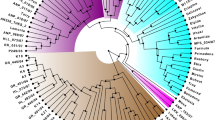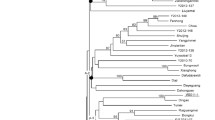Abstract
In this study, we developed a total of 37 simple sequence repeat (SSR) markers from 11 bacterial artificial chromosome (BAC) clone sequences anchored on chromosome 12 of tomato available at Solanaceae Genomics Network. These SSR markers could group a set of 16 tomato genotypes comprising of Solanum lycopersicum, S. pimpinellifolium, S. habrochaites, and S. pennellii unambiguously according to their known species status. Clear subgroups of genotypes within S. lycopersicum were also observed. A subset of 16 SSR markers representing the 11 BAC clones was used for developing genetic linkage maps of three interspecific F2 populations produced from the crosses involving a common S. lycopersicum parent (CLN2498E) with S. pennellii (LA1940), S. habrochaites (LA407) and S. pimpinellifolium (LA1579). The length of the genetic linkage maps were 112.5 cM, 109.3 cM and 114.1 cM, respectively. Finally, an integrated genetic linkage map spanning a total length of 118.7 cM was developed. The reported SSR markers are uniformly distributed on chromosome 12 and would be useful for genetic diversity and mapping studies in tomato.




Similar content being viewed by others
References
Arens P, Odinot P, van Heusden AW, Lindhout P, Vosman B (1995) GATA-and GACA-repeats are not evenly distributed throughout the tomato genome. Genome 38:84–90
Areshchenkova T, Ganal MW (1999) Long tomato microsatellites are predominantly associated with centromeric regions. Genome 42:536–544
Areshchenkova T, Ganal MW (2002) Comparative analysis of polymorphism and chromosomal location of tomato microsatellite markers isolated from different sources. Theor Appl Genet 104:229–235
Bai Y, Huang CC, van der Hulst R, Meijer-Dekens F, Bonnema G, Lindhout P (2003) QTLs for tomato powdery mildew resistance (Oidium lycopersici) in Lycopersicon parviflorum G1.1601 co-localize with two qualitative powdery mildew resistance genes. Mol Plant Microbe Interact 16(2):169–176
Bernacchi D, Tanksley SD (1997) An interspecific backcross of Lycopersicon esculentum × L. hirsutum: linkage analysis and a QTL study of sexual compatibility factors and floral traits. Genetics 147:861–877
Broun P, Tanksley D (1996) Characterization and genetic mapping of simple repeat sequences in the tomato genome. Mol Gen Genet 250:39–49
Chen FQ, Foolad MR (1999) A molecular linkage map of tomato based on a cross between Lycopersicon esculentum and L. pimpinellifolium and its comparison with other molecular maps of tomato. Genome 42:94–103
Chungwongse J, Bunn TB, Crossman C, Jiang J, Tanksley D (1994) Chromosomal localization and molecular marker tagging of the powdery mildew resistance gene (Lv) in tomato. Theor Appl Genet 89(1):76–79
Dakin EE, Avise JC (2004) Microsatellite null alleles in parentage analysis. Heredity 93:504–509
deVicente MC, Tanksley SD (1993) QTL analysis of transgressive segregation in an interspecific tomato cross. Genetics 134:585–596
Doligez A, Adam-Blondon AF, Cipriani G, Gaspero DG, Laucou V, Merdinoglu D, Meredith CP, Riaz S, Roux C, This P (2006) An integrated SSR map of grapevine based on five mapping populations. Theor Appl Genet 113:369–382
Foolad MR (1996) Unilateral incompatibility as a major cause of skewed segregation in the cross between Lycopersicon esculentum and L. pennellii. Plant Cell Rep 15:627–633
Foolad MR, Zhang LP, Khan AA, Nino-Liu D, Lin GY (2002) Identification of QTLs for early blight (Alternaria solani) resistance in tomato using backcross populations of a Lycopersicon esculentum × L. hirsutum cross. Theor Appl Genet 104:945–958
Frary A, Presting GG, Tanksley SD (1996) Molecular mapping of the centromeres of tomato chromosomes 7 and 9. Mol Gen Genet 250:295–304
Frary A, Xu Y, Liu J, Mitchell S, Tedeschi E, Tanksley SD (2005) Development of a set of PCR-based anchor markers encompassing the tomato genome and evaluation of their usefulness for genetics and breeding experiments. Theor Appl Genet 111(2):291–312
Fulton TM, Chunwongse J, Tanksley SD (1995) Microprep protocol for extraction of DNA from tomato and other herbaceous plants. Plant Mol Biol Rep 13:207–209
Geethanjali S, Chen KY, Pastrana DV, Wang JF (2010) Development and characterized of tomato SSR markers from genomic sequences of anchored BAC clones on chromosome 6. Euphytica 173:85–97
Grandillo S, Tanksley SD (1996) Genetic analysis of RFLPs, GATA microsatelllites and RAPDs in a cross between L. esculentum and L. pimpinellifolium. Theor Appl Genet 92:957–965
Grist SA, Firgaira FA, Morley AA (1993) Dinucleotide repeat polymorphisms isolated by the polymerase chain reaction. BioTechniques 15:304–309
Harushima Y, Nakagahra M, Yano M, Sasaki T, Kurata N (2001) A genome-wide survey of reproductive barriers in an intraspecific hybrid. Genetics 159:883–892
He C, Poysa V, Yu K (2003) Development and characterization of simple sequence repeat (SSR) markers and their use in determining relationships among Lycopersicon esculentum cultivars. Theor Appl Genet 106:363–373
Kosambi D (1944) The estimation of map distances from recombination values. Ann Eugen 12:172–175
Lee HR, Bae IH, Park SW, Kim HJ, Min WK, Han JH, Kim KT, Kim BD (2009) Construction of an Integrated Pepper Map Using RFLP, SSR, CAPS, AFLP, WRKY, rRAMP, and BAC End Sequences. Mol Cells 27:21–37
Milbourne D, Meyer RC, Collins AJ, Ramsay LD, Gebhardt C, Waugh R (1998) Isolation, characterization and mapping of simple sequence repeat loci in potato. Mol Gen Genet 259:233–245
Minamiyama Y, Tsuro M, Hirai M (2006) An SSR-based linkage map of Capsicum annuum. Mol Breed 18:157–169
Mueller LA, Lankhorst RK, Tanksley SD, Giovannoni JJ et al (2009) A snapshot of the emerging tomato genome sequence. Plant Genome 2:78–92
Nei M (1973) Analysis of gene diversity in subdivided populations. Proc Natl Acad Sci USA 70:3321–3323
Ohyama A, Asamizu E, Negoro S, Miyatake K, Yamaguchi H, Tabata S, Fukuoka H (2009) Characterization of tomato SSR markers developed using BAC-end and cDNA sequences from genome database. Mol Breed 23:685–691
Olivier J, Thoquet P, Sperisen C, Rogowsky P, Stephens S, Bonnema G, Lewis C, Nazer R, Tanksley S, Gebhardt C, Grimsley N (1995) Restriction Fragment Length Polymorphisms between tomato lines sensitive or tolerant to bacterial wilt. Rept Tomato Genetics Coop 45:32–33
Perrier X, Jacquemoud-Collet JP (2006) DARwin software http://darwin.cirad.fr/darwin
Radhika P, Gowda SJM, Kadoo NY, Mhase LB, Jamadagni BM, Sainani MN, Chandra S, Gupta VS (2007) Development of an integrated intra-specific map of chickpea (Cicer arietinum L.) using two recombinant inbred line populations. Theor Appl Genet 115:209–216
Rick CM, DeVerna JW, Chetelat RT, Stevens MA (1987) Potential contributions of wide crosses to improvement of processing tomatoes. Acta Hort 200:45–55
Robert VJM, West MAL, Inai S et al (2001) Marker-assisted introgression of blackmold resistance QTL alleles from wild Lycopersicon cheesmanii to cultivated tomato (L. esculentum) and evaluation of QTL phenotypic effects. Mol Breed 8:217–233
Sanwen H, Baoxi Z, Milbourne D, Cardle L, Guimei Y, Jiazhen G (2000) Development of pepper SSR markers from sequence databases. Euphytica 117:163–167
Sharma A, Zhang L, Nino-Liu D, Ashrafi H, Foolad MR (2008) A Solanum lycopersicum × Solanum pimpinellifolium linkage map of tomato displaying genomic locations of R-Genes, RGAs, and candidate resistance/defense-response ESTs. Int J Plant Genomics. doi:10.1155/2008/926090
Shirasawa K, Asamizu E, Fukuoka H, Ohyama A, Sato S, Nakamura Y, Tabata S, Sasamoto S, Wada T, Kishida Y, Tsuruoka H, Fujishiro T, Yamada M, Isobe S (2010) An interspecific linkage map of SSR and intronic polymorphism markers in tomato. Theor Appl Genet 121:731–739
Shultz JL, Kazi S, Bashir R, Afzal JA, Lightfoot DA (2007) The development of BAC-end sequence-based microsatellite markers and placement in the physical and genetic maps of soybean. Theor Appl Genet 114:1081–1090
Smulders MJ, Bredemeijer G, Rus-Kortekaas W, Arens P, Vosman B (1997) Use of short microsatellites from database sequences to generate polymorphisms among Lycopersicon esculentum cultivars and accessions of other Lycopersicon species. Theor Appl Genet 97:264–272
Stamova BS, Chetelat RT (2000) Inheritance and genetic mapping of cucumber mosaic virus resistance introgressed from Lycopersicon chilense into tomato. Theor Appl Genet 101:527–537
Suliman-Pollatschek S, Kashkush K, Shats H, Hillel J, Lavi U (2002) Generation and mapping of AFLP, SSRs and SNPs in Lycopersicon esculentum. Cell Mol Biol Lett 7:583–597
Tanksley SD, Ganal MW, Prince JP, De Vicente MC, Bonierbale MW, Broun P, Fulton TM, Giovannoni JJ, Grandillo S, Martin GB, Messeguer R, Miller JC, Miller L, Paterson AH, Pineda O, Roder MS, Wing RA, Wu W, Young ND (1992) High-density molecular linkage maps of the tomato and potato genomes. Genetics 132:1141–1160
Tautz D, Renz M (1984) Simple sequences are ubiquitous repetitive components of eukaryotic genomes. Nucl Acid Res 12:4127–4138
Thomas MR, Scott NS (1993) Microsatellite repeats in grapevine reveal DNA polymorphisms when analyzed as sequence-tagged sites (STSs). Theor Appl Genet 86:985–990
Thoquet P, Olivier J, Sperisen C, Rogowsky P, Laterrot H, Grimsley NH (1996) Quantitative trait loci determining resistance to bacterial wilt in tomato cultivar Hawaii7996. Mol Plant Microbe Interact 9:826–836
Trognitz BR, Schmiediche PE (1993) A new look at the incompatibility relationships in higher plants. Sex Plant Reprod 6:183–190
van Ooijen JW, Voorrips RE (2001) JoinMap® 3.0: Software for the calculation of genetic linkage maps. Plant Research International, Wageningen, The Netherlands
Voorrips RE (2002) Mapchart: software for the graphical presentation of linkage maps and QTLs. J Hered 93:77–78
Wang JF, Olivier J, Thoquet P, Mangin B, Sauviac L, Grimsley NH (2000) Resistance of tomato line Hawaii7996 to Ralstonia solanacearum Pss4 in Taiwan is controlled mainly by a major strain-specific locus. Mol Plant Microbe Interact 13:6–13
Yaghoobi J, Yates JL, Williamson VM (2005) Fine mapping of the nematode resistance gene Mi-3 in Solanum peruvianum and construction of a S. lycopersicum DNA contig spanning the locus. Mol Gen Genomics 274:60–69
Yi G, Lee JM, Lee S, Choi D, Kim BD (2006) Exploitation of pepper EST-SSRs and an SSR-based linkage map. Theor Appl Genet 114:113–130
Zhang LP, Khan A, Niño-Liu D, Foolad MR (2002) A molecular linkage map of tomato displaying chromosomal locations of resistance gene analogs based on a Lycopersicon esculentum × Lycopersicon hirsutum cross. Genome 45(1):133–146
Acknowledgments
The authors would like to thank Dr. Peter Hanson for providing information on tomato accessions, and Ms. Chiou-fen Hsu for technical assistance. This study is supported by funding provided by GTZ 81070160: Deutsche Gesellshaft fuer Technishe Zusammenarbeit GmbH of Germany.
Author information
Authors and Affiliations
Corresponding author
Rights and permissions
About this article
Cite this article
Geethanjali, S., Kadirvel, P., de la Peña, R. et al. Development of tomato SSR markers from anchored BAC clones of chromosome 12 and their application for genetic diversity analysis and linkage mapping. Euphytica 178, 283–295 (2011). https://doi.org/10.1007/s10681-010-0331-8
Received:
Accepted:
Published:
Issue Date:
DOI: https://doi.org/10.1007/s10681-010-0331-8




